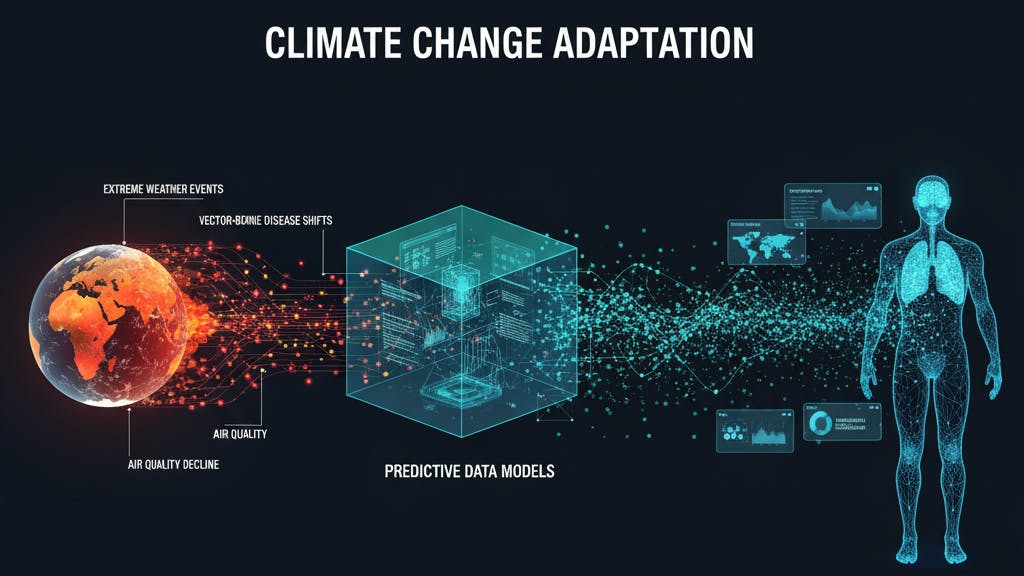When I first looked at hospital data against local weather patterns, it hit me. Climate isn’t just an environmental issue. It’s a health factor.
According to PubMed’s report, heat-related deaths among people over 65 jumped by 167% compared to the 1990s. Similar to this, Yale Medicine reported that the average person experienced 50 extra days of dangerous heat in a year.
We realized healthtech had to adapt. It’s no longer enough to track symptoms and vitals. We need tools that monitor environmental triggers, analyze them, and give actionable insights.
Air Quality: The Silent Factor
- As per EEA, PM2.5 exposure above WHO limits caused 269,000 premature deaths in Europe in 2024.
- Chronic illnesses like asthma, COPD, and heart disease spike with poor air quality.
In our apps, we now integrate live air quality data. Patients receive alerts when pollution levels rise. Doctors can plan interventions proactively. These small environmental changes trigger real health events, and we can now act faster.
UV Exposure: Often Ignored
UV radiation affects skin, eyes, and immune health. Overexposure can lead to skin cancer and cataracts. Yet it rarely enters predictive health models.
- Wearables often provide real-time UV exposure.
- Combining this with health data helps identify triggers for flare-ups in autoimmune diseases or fatigue cycles.
Integrating UV data adds another layer of protection. It’s about anticipating health risks before they become emergencies.
Predictive Models: Turning Data into Action
We build predictive models that combine:
- Geo-specific environmental data like air quality, UV, and temperature.
- Individual health metrics like vitals, medication, and chronic conditions.
- Clinical validation, ensuring predictions are accurate and actionable.
Healthtech companies now combine environmental and patient data into predictive systems. Key applications include:
Feature | Current Use | Verified Impact |
Air Quality (PM2.5) | Real-time monitoring & alerts for patients with respiratory conditions | Reduces hospital visits, improves patient outcomes |
Heat & Weather | Predictive models for heat-related illnesses | Forecasts heat-related hospital admissions; helps allocate healthcare resources |
Respiratory Triggers (combined environmental factors) | Integrated dashboards for hospitals | Improves planning for respiratory care and emergency readiness |
Why HealthTech Companies Must Adapt
As a founder in healthtech, I’ve seen firsthand how ignoring environmental factors can limit the impact of digital health solutions. Integrating climate and environmental data into software is becoming essential for three major reasons:
1. Patient Outcomes
Proactive care saves lives. For example, real-time air quality alerts can prevent asthma attacks or COPD flare-ups before they happen. Predictive heat models can warn elderly patients of extreme temperatures, reducing hospital admissions.
Software that combines environmental data with patient health metrics gives clinicians a head start, turning reactive care into preventive care.
2. Operational Efficiency
Hospitals are under constant pressure to optimize resources. Predictive models based on air quality, UV, and temperature data help staff anticipate surges in admissions, especially during heatwaves or pollution spikes.
This allows hospitals to allocate beds, staff, and emergency services efficiently, improving both workflow and patient safety.
3. Market Demand
Investors, insurers, and healthcare providers increasingly value solutions that are climate-aware and data-driven. Startups and established healthtech companies that incorporate environmental data into their platforms are more likely to attract funding, partnerships, and adoption.
Predictive health tools are becoming the standard.
Challenges We Face
Some of the key challenges include:
1. Data Privacy
Environmental data combined with personal health information is highly sensitive. Misuse or breaches could put patients at risk. That’s why we rely on federated learning, strong encryption, and strict access controls.
2. Data Quality
Predictive models are only as good as the data they receive. Incomplete, outdated, or low-resolution environmental data can lead to inaccurate forecasts, potentially putting patients at risk.
Healthtech companies must prioritize high-quality sensors, validated datasets, and continuous calibration to maintain reliability.
3. Adoption
Even the best software is useless if clinicians don’t trust or use it. Early engagement, training programs, and integrating predictive tools into existing workflows are key.
Demonstrating clear, measurable benefits, like reduced hospital visits or better resource allocation, helps drive adoption and ensures these tools are actively used in decision-making.
The Path Forward
Climate-aware healthtech is just beginning, but the potential is huge. The next five years will likely see:
1. More real-time environmental integrations (air, UV, temperature):
Apps and hospital dashboards will pull live data from sensors, satellites and wearables, giving clinicians and patients instant insights to act on before health events occur.
2. AI-driven predictive analytics improving chronic care management:
Machine learning models will combine environmental and personal health data to anticipate flare-ups, hospital admissions and emergency needs, helping healthcare providers intervene proactively.
3. Global scaling – solutions customized to regional environmental patterns:
From polluted urban centers to regions with extreme heat, healthtech platforms will adapt predictive models for local climates, making care more precise and relevant across different geographies.
Our goal is simple!
Make healthcare smarter, faster, and safer by integrating environmental data as a core part of care planning, risk management, and patient engagement.
Key Takeaways
- Climate directly affects health like heat, pollution, and UV aren’t just background data.
- Healthtech can integrate environmental data to predict risks and prevent hospitalizations.
- Thousands of preventable deaths are linked to climate factors.
- Proactive, predictive solutions benefit patients, clinicians, and the healthcare system alike.


